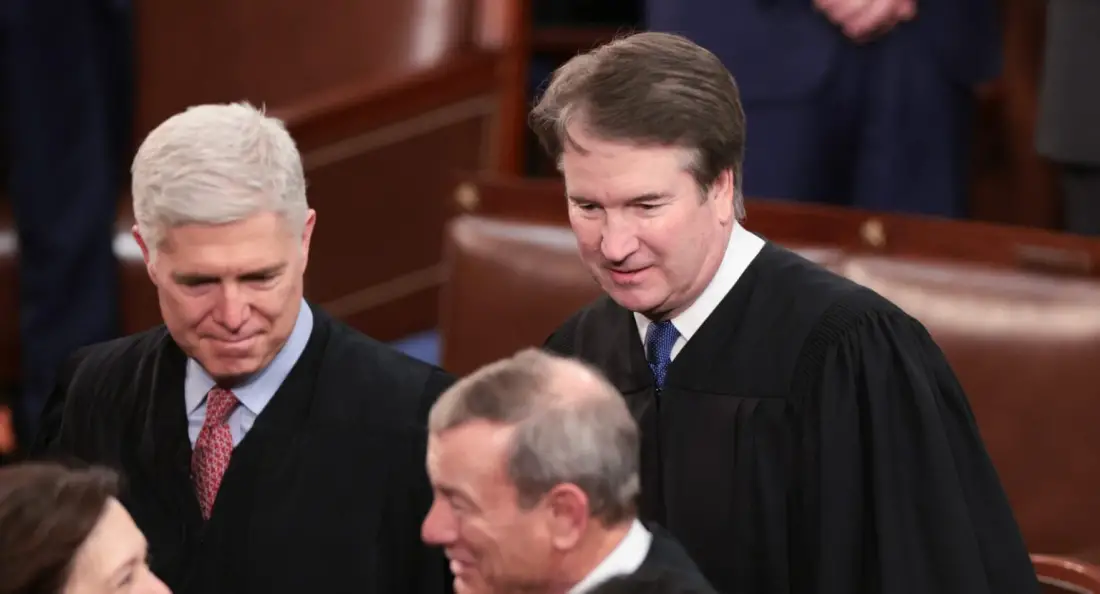Gorsuch and Kavanaugh Deliver a Sharp Reminder
Two of the Supreme Court’s most influential conservative justices — Neil Gorsuch and Brett Kavanaugh — have delivered an unmistakable warning to lower court judges: stop ignoring Supreme Court precedent.
The warning came this summer as the Court weighed in on a string of cases involving the Trump administration, including one tied to the cancellation of $800 million in federal research grants.
Justice Gorsuch, writing for the majority, said bluntly:
“Lower court judges may sometimes disagree with this court’s decisions, but they are never free to defy them.”
Justice Kavanaugh joined his opinion, underscoring the seriousness of the rebuke.
Gorsuch added that it was “the third time in a matter of weeks” that the Court had to intervene after lower courts failed to apply binding precedent.
“When this court issues a decision, it constitutes a precedent that commands respect in lower courts,” he wrote.
The Case That Sparked the Warning
The dispute centered on a district court ruling by Judge William Young, who blocked Trump’s freeze on federal research funding — a freeze tied to an internal audit revealing questionable race-based grant allocation practices.
Judge Young, in his ruling, claimed he had “never seen government racial discrimination like this.”
The Supreme Court strongly disagreed, overturning his decision and allowing the freeze to remain in place while litigation proceeds.
In doing so, the justices signaled that lower courts cannot treat emergency orders or unsigned opinions as optional guidance. They are precedent — and must be followed.
A Broader Pattern of Judicial Defiance
This case wasn’t isolated. Over the past year, the high court has repeatedly had to step in after district judges refused to comply with emergency orders related to Trump-era policies on immigration, agency oversight, and executive authority.
Justice Samuel Alito called one such instance an “act of judicial hubris,” warning that defiance by lower courts threatens the constitutional hierarchy of the judiciary itself.
“When courts below us disregard controlling precedent, they undermine not only this Court’s authority but the rule of law itself,” Alito wrote in a concurring opinion earlier this year.
Legal analysts say this growing pattern — particularly among certain left-leaning district courts — reflects an activist streak that views Supreme Court rulings as political, not binding.
The Liberal Dissent: ‘Calvinball Jurisprudence’
Not all the justices agreed with Gorsuch and Kavanaugh’s approach.
Justice Ketanji Brown Jackson, dissenting in the NIH funding case, mocked the majority’s reliance on prior emergency rulings, comparing it to “Calvinball” — the fictional game from Calvin and Hobbes with ever-changing rules.
“Calvinball has only one rule: there are no fixed rules,” she wrote. “We seem to have two: that one, and this administration always wins.”
Justice Sonia Sotomayor echoed Jackson’s criticism in a separate dissent this summer, accusing the Court of “rewarding lawlessness” and “closing its eyes to noncompliance.”
“This is not the first time the court closes its eyes to noncompliance, nor, I fear, will it be the last,” Sotomayor wrote.
Conservative Legal Scholars Push Back
Conservative legal figures defended Gorsuch and Kavanaugh’s warning, arguing that judicial defiance threatens the integrity of the system.
James Burnham, a former Gorsuch clerk who served in the Trump administration, called the trend “unprecedented and extraordinary.”
“The defiance of the Supreme Court’s emergency orders by some lower courts is unprecedented, extraordinary, and the Supreme Court must deal with it decisively,” Burnham said.
Carrie Severino, president of the Judicial Crisis Network, added that it had “become necessary to remind district judges not to flout orders of the Supreme Court.”
Emergency Orders and Their Weight
At the heart of this debate lies a technical but crucial question: how binding are the Supreme Court’s emergency or “shadow docket” rulings?
Traditionally, unsigned emergency orders are treated as temporary — not fully precedential. But recent opinions have made clear that such rulings should guide outcomes in related cases until a full decision is issued.
In July, for instance, the justices sided with Trump’s removal of three Biden-appointed Consumer Product Safety Commission members, citing a nearly identical emergency order from a prior case involving federal labor agencies.
The Court said the issue was “squarely controlled” by its previous order — a direct rebuke to the district court that had ignored it.
Reining in Nationwide Injunctions
The Supreme Court also issued a major ruling limiting the power of district judges to impose nationwide injunctions — sweeping orders that block federal policies across all states.
That decision arose from a lawsuit challenging Trump’s executive order to end birthright citizenship. The Court held that lower judges exceeded their authority by freezing an entire federal policy based on a single district case.
Justice Gorsuch has long argued that such injunctions “encourage forum shopping and invite chaos.”
A Divided Court, but a Unified Message
Even some liberal justices have expressed concern about the growing tension between the Supreme Court and lower benches.
Speaking in California this summer, Justice Elena Kagan admitted the high court could “explain things better” to help judges apply emergency rulings more consistently.
Days later, in remarks to a judicial conference in Kansas City, Justice Kavanaugh reminded judges of their constitutional duty:
“Members of the judiciary have an important responsibility that goes with maintaining independence — the responsibility to get it right, to do our hard work, to understand our role in a constitutional democracy,” he said. “We’re not the policymakers.”
The Takeaway
The Supreme Court’s latest warning isn’t just about one grant dispute — it’s about the chain of command within the judicial system.
When lower courts openly defy binding precedent, the justices argue, it’s not “judicial independence” — it’s an erosion of constitutional order.
As Gorsuch put it:
“When this Court issues a decision, it is not a suggestion. It is the law of the land.”
And for the federal judiciary, that’s not just a reminder — it’s a line in the sand.

Adrian Hawthorne is a celebrated author and dedicated archivist who finds inspiration in the hidden stories of the past. Educated at Oxford, he now works at the National Archives, where preserving history fuels his evocative writing. Balancing archival precision with creative storytelling, Adrian founded the Hawthorne Institute of Literary Arts to mentor emerging writers and honor the timeless art of narrative.
